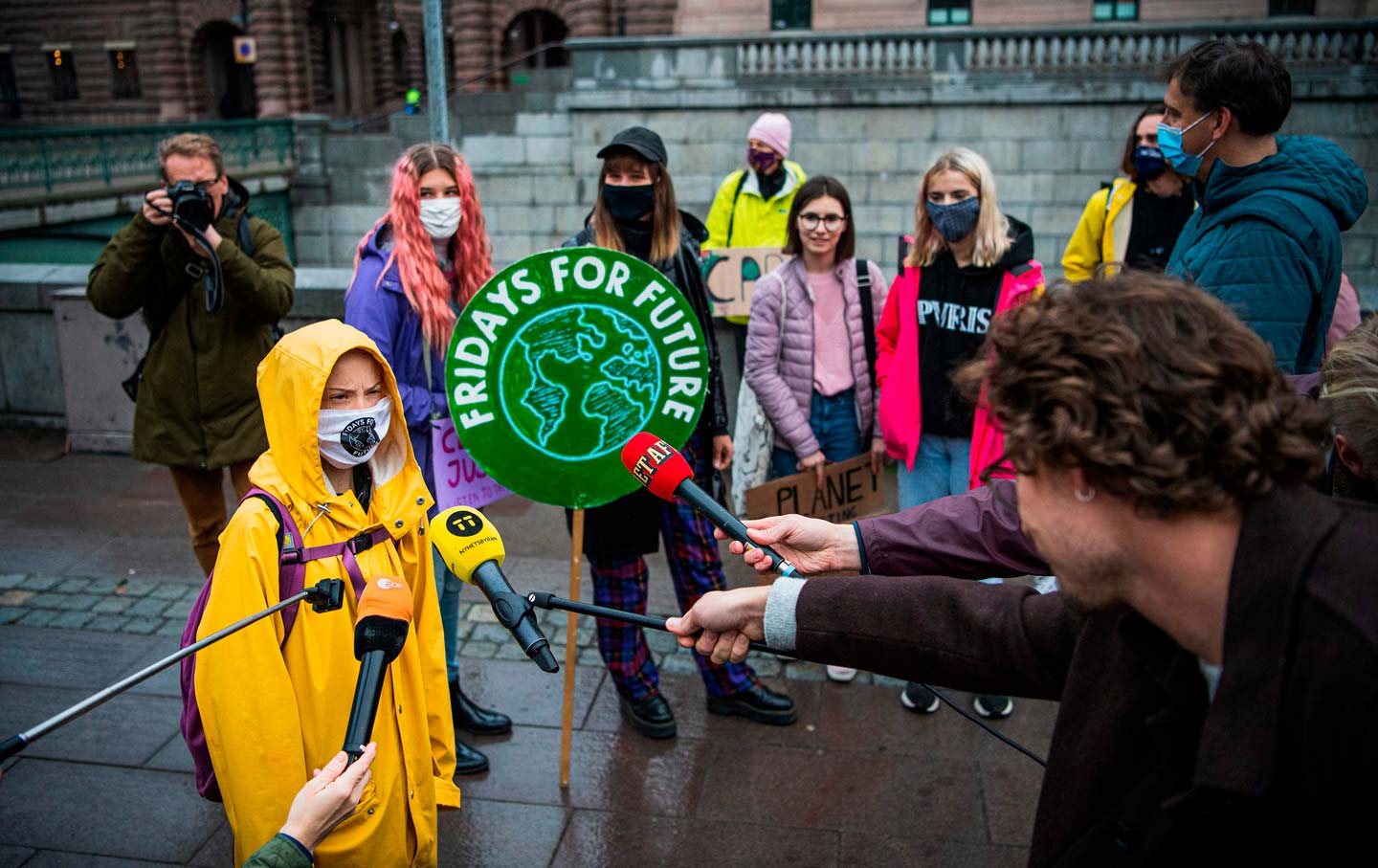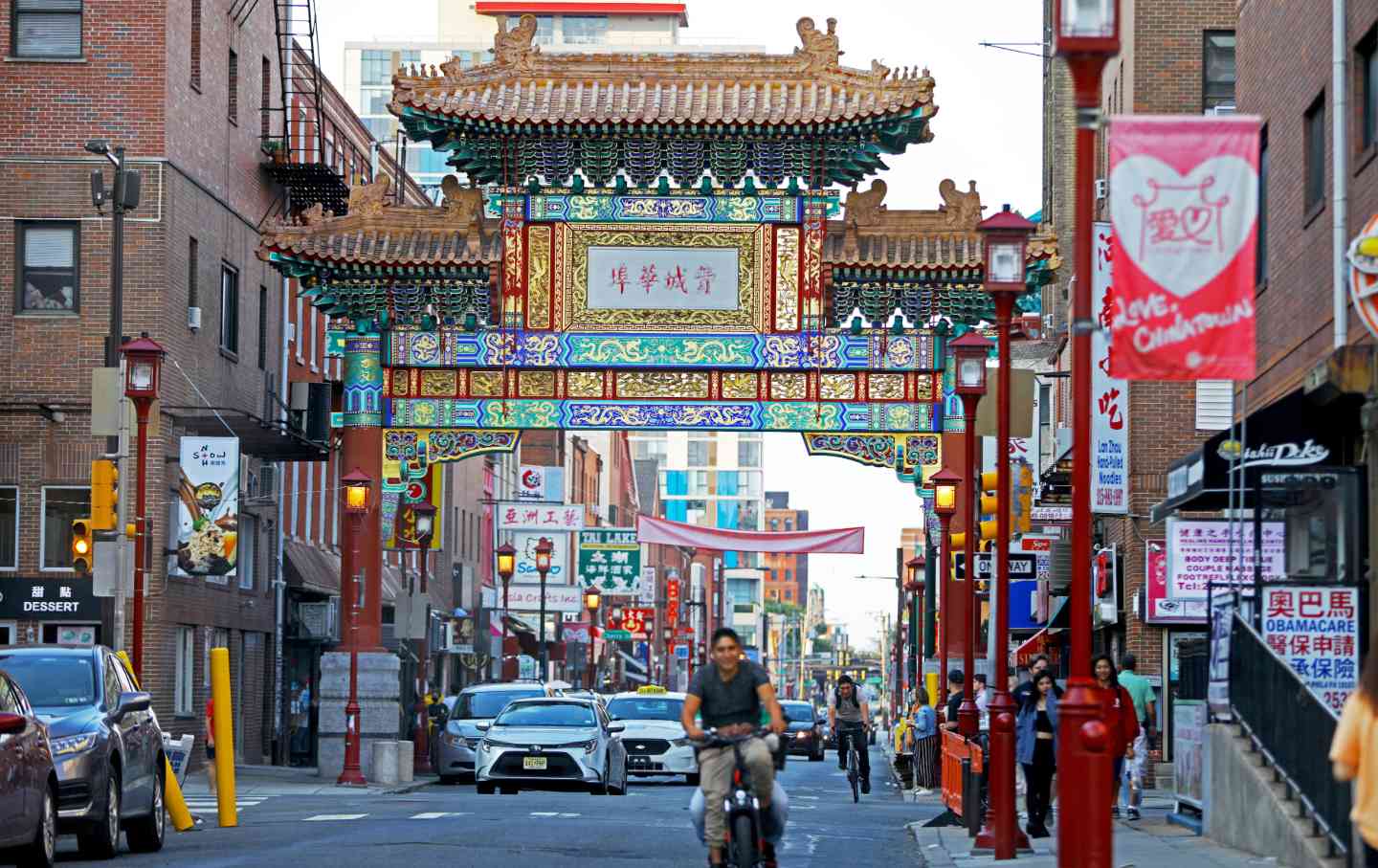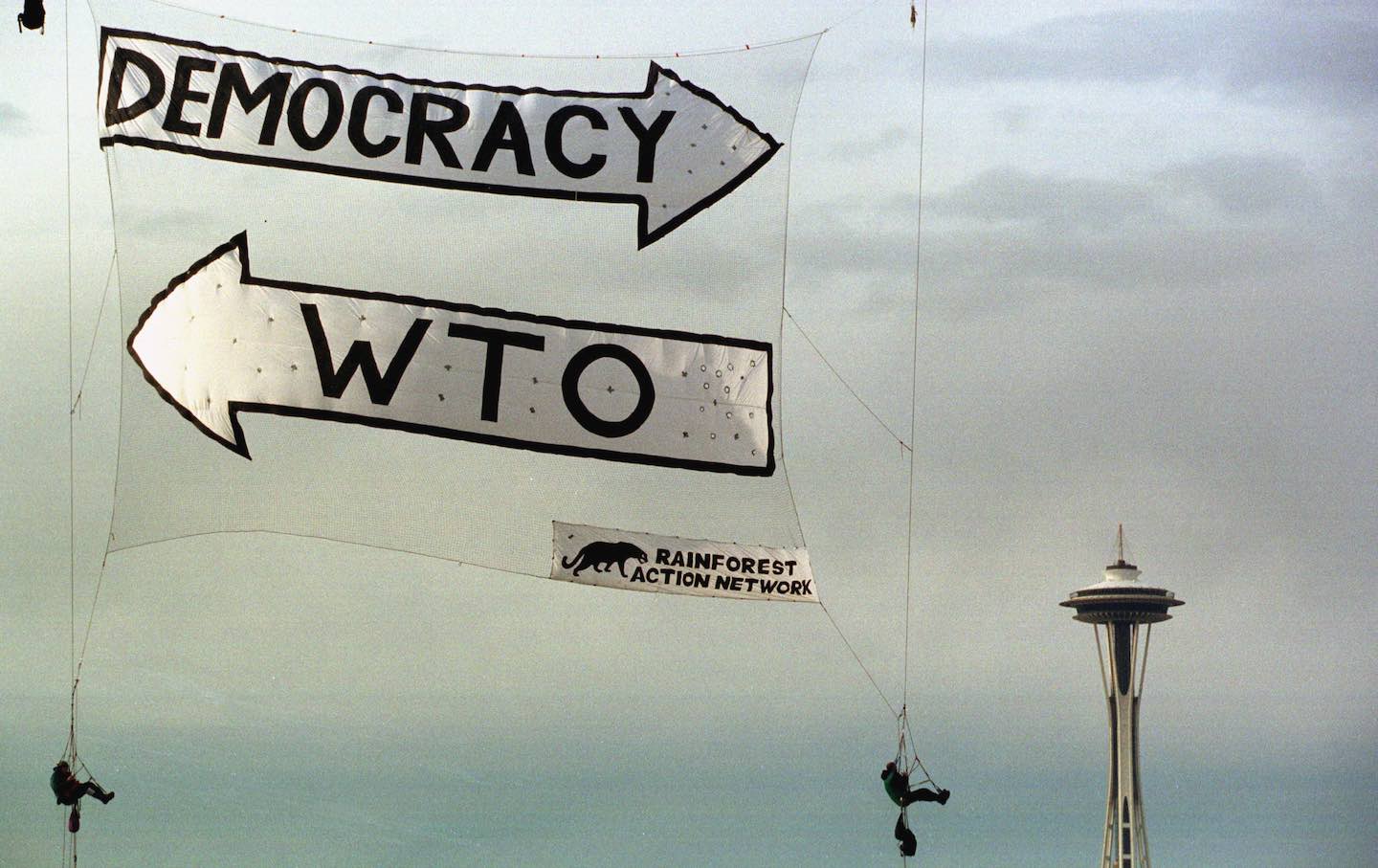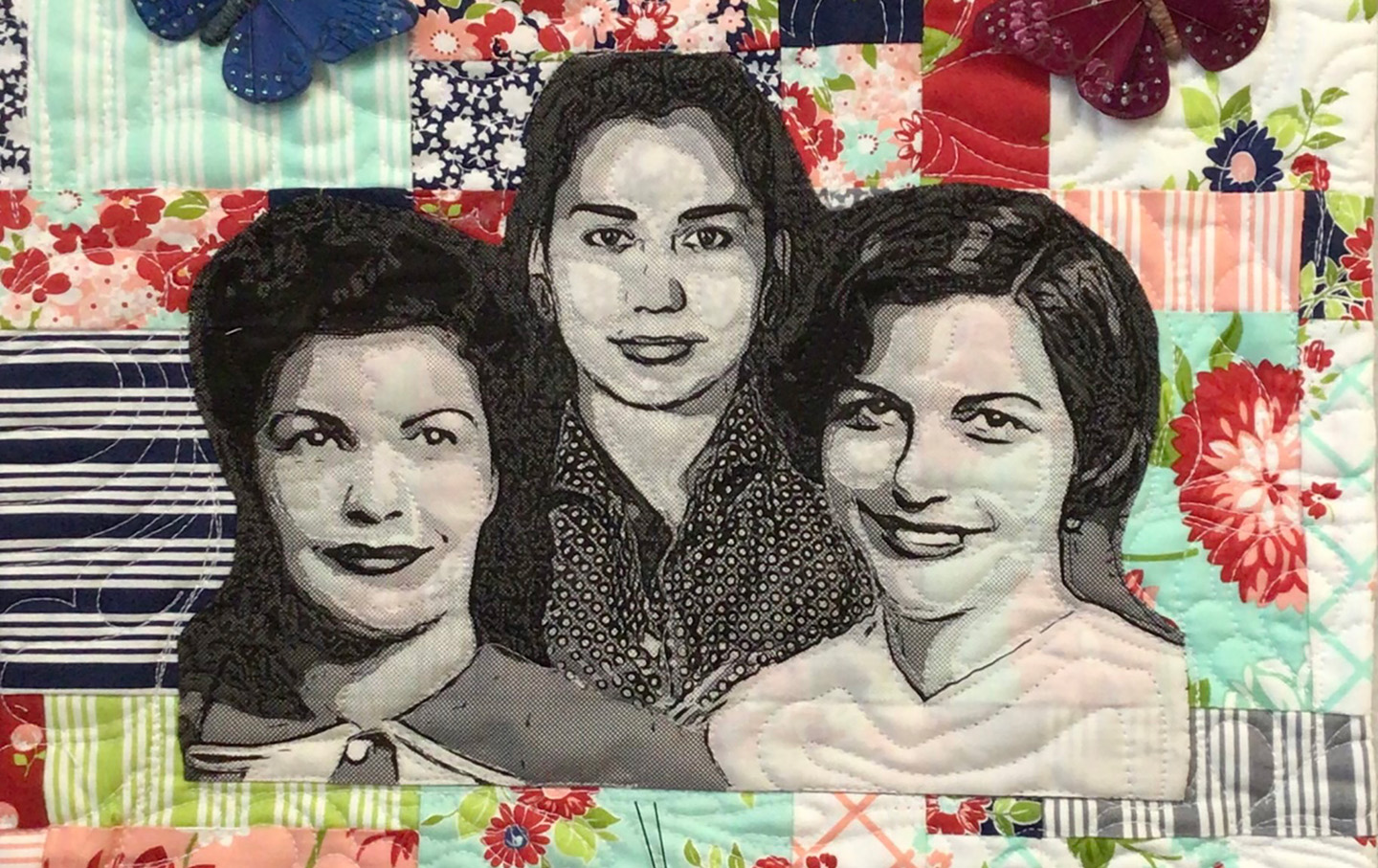We Underestimate Young People. That’s a Mistake.
Younger generations are out there leading the way toward justice in a fashion that they seldom get credit for.

Swedish climate activist Greta Thunberg during a “Fridays for Future” protest.
(Jonathan Nackstrand / AFP via Getty Images)This article originally appeared at TomDispatch.com. To stay on top of important articles like these, sign up to receive the latest updates from TomDispatch.com.
“All Americans owe them a debt for—if nothing else—releasing the idealism locked so long inside a nation that has not recently tasted the drama of a social upheaval. And for making us look on the young people of the country with a new respect.” That’s how Howard Zinn opened his book The New Abolitionists about the Student Nonviolent Coordinating Committee of the 1960s. Zinn pointed out a truth from the Black freedom struggles of that era and earlier: that young people were often labeled aloof and apathetic, apolitical and uncommitted—until suddenly they were at the very forefront of justice struggles for themselves and for the larger society. Connected to that truth is the reality that, in the history of social-change movements in the United States and globally, young people almost invariably find themselves in the lead.
I remember first reading The New Abolitionists in the 1990s when I was a college student and activist. I had grown weary of hearing older people complain about the inactivity of my generation, decrying why we weren’t more involved in the social issues of the day. Of course, even then, such critiques came in the face of mass protests, often led by the young, against the first Iraq war (launched by President George H.W. Bush), the Republican Contract With America, and the right-wing “family values” movement. Such assertions about the apathy of youth were proffered even as young people were waging fights for marriage equality, the protection of abortion, and pushing back against the attack on immigrants, as well as holding mass marches like the Battle for Seattle at the World Trade Organization meeting as well as protests at the Republican National Convention of 2000, and so much more.
Another quote from Zinn remains similarly etched in my mind. “Theirs,” he wrote, “was the silent generation until they spoke, the complacent generation until they marched and sang, the money-seeking generation until they gave it up for…the fight for justice in the dank and dangerous hamlets of the Black Belt.”
And if it was true that, in the 1990s and 2000s, young people were so much less complacent than was recognized at the time, it’s even truer (to the nth degree!) in the case of the Millennials and Gen Z today. Younger generations are out there leading the way toward justice in a fashion that they seldom get credit for.
Don’t Look Up
Let me suggest, as a start, that we simply chuck out the sort of generalizations about Millennials and Gen Z that pepper the media today: that those younger generations spend too much money on avocado toast and Starbucks when they should be buying real estate or paying down their student loans. Accused of doing everything through social media, it’s an under-recognized and unappreciated reality of this century that young people have been showing up in a remarkable fashion, leading the way in on-the-ground movements to ensure that Black lives matter, dealing vividly with the onrushing horror of climate change, as well as continued conflict and war, not to speak of defending economic justice and living wages, abortion access, LGBTQ rights, and more.
Take, for instance, the greatest social upheaval of the past five years: the uprising that followed the murders of George Floyd and Breonna Taylor, with #BlackLivesMatter protests being staged in staggering numbers of communities, many of which had never hosted such an action before. Those marches and rallies, led mainly by teenagers and young adults, may have been the broadest wave of protests in American history.
When it comes to the environmental movement, young people have been organizing campaigns for climate justice, calling for a #GreenNewDeal and #climatedefiance from Cop City to the March to End Fossil Fuels to a hunger strike in front of the White House. At the same time, they have been bird-dogging politicians on both sides of the aisle with an urgency and militancy not previously associated with climate change. Meanwhile, a surge of unionization drives, whether at Walmart, Starbucks, Amazon, or Dollar General, has largely been led by young low-wage workers of color and has increased appreciation for and recognition of workers’ rights and labor unions to a level not seen in decades. Add to that the eviction moratoriums, mutual-aid provisions, and student-debt strikes of the pandemic years, which gained ground no one had thought possible even months earlier.
And don’t forget the movement to stop gun violence that, from the March for Our Lives in Florida to the protests leading to the expulsion and subsequent reinstatement of state legislators Justin Jones and Justin Pearson in Tennessee, galvanized millions across racial and political lines. Teenagers in striking numbers are challenging this society to value their futures more than guns. And most recently, calls for a #ceasefirenow and #freepalestine have heralded the birth of a new peace movement in the wake of Hamas’s attacks on Israel and the Israeli destruction of much of Gaza. Although university presidents have been getting more media attention, Palestinian, Jewish, and Muslim students have been the ones organizing and out there, insisting that indiscriminate violence perpetrated against Palestinians, especially children, will not happen “in our name.”
From Unexpected Places
An observation Zinn made so many years ago about young people in the 1960s may have lessons for movements today: “They came out of unexpected places; they were mostly black and therefore unseen until they suddenly became the most visible people in America; they came out of Greensboro, North Carolina, and Nashville, Tennessee, and Rock Hill, South Carolina, and Atlanta, Georgia. And they were committed. To the point of jail, which is a large commitment.”
Today’s generation of activists are similarly committed and come from places as varied as Parkland, Fla., Uvalde, Tex., Buffalo, N.Y., and Durham, N.C. Below the surface, some deep stuff is brewing that could indeed continue to compel new generations of the young into action. As we approach the first quarter mark of the 21st century, we’re stepping firmly into a new technological era characterized by unparalleled levels of digital power. The Fourth Industrial Revolution, as elite economists and think-tankers like to call it, promises a technological revolution that, in the words of World Economic Forum founder Klaus Schwab, is likely to occur on a “scale, scope, and complexity” never before experienced. That revolution will, of course, include the integration of artificial intelligence and other labor-replacing technology into many kinds of in-person as well as remote work and is likely to involve the “deskilling” of our labor force from the point of production all the way to the market.
Residents of Detroit, once the Silicon Valley of auto manufacturing, understand this viscerally. At the turn of the 20th century, the Ford River Rouge Plant was the largest, most productive factory in the world, a private city with 100,000 workers and its own municipal services. Today, the plant employs only a fraction of that number—about 10,000 people—and yet, thanks to a surge of robotic innovation, it produces even more cars than it did in the heady days of the 1930s. Consider such a shift just the tip of the spear of the kind of change “coming to a city near you,” as one veteran auto worker and union organizer once told me. All of this is impacting everything from wages to healthcare plans, pensions to how workers organize. Indeed, some pushback to such revolutionary shifts in production can be seen in the labor strikes the United Auto Workers launched late in 2023.
Overall, such developments are deeply impacting young people. After all, workers are now generally making less than their parents did, even though they may produce more for the economy. Growing parts of our workforce are increasingly non-unionized, low-wage, part-time and/or contracted out, often without benefits like health care, paid sick leave, or retirement plans. And not surprisingly, such workers struggle to afford housing, childcare, and other necessities, experiencing on the whole harsher lives than the generations that preceded them.
In addition, the last 40 years have done more than just transform work and daily life for younger generations. They have conditioned so many to lose faith in government as a site for struggle and change. Instead, Americans are increasingly dependent on private, market-based solutions that extol the wealthy for their humanitarianism (even as they reap the rewards from federal policymaking and an economy rigged in their favor).
Crises upon Crises
Popular
“swipe left below to view more authors”Swipe →Consider the social, political, and economic environment that’s producing the multilayered crises faced by today’s younger generations. When compared to other advanced countries, the United States lags perilously behind in almost every important category. In this rich land, about 45 million people regularly experience hunger and food insecurity, nearly 80 million are uninsured or underinsured, close to 10 million live without housing or on the brink of homelessness, while the education system continues to score near the bottom compared to the other 37 countries in the Organization for Economic Co-operation and Development. And in all of this, young people are impacted disproportionately.
Perhaps most damning, ours is a society that has become terrifyingly tolerant of unnecessary death and suffering. Deaths by poverty are an increasingly all-American reality. Low-wage jobs that have been found to shorten lives are the norm. In 2023, researchers at the University of California, Riverside, found that poverty was the fourth-leading cause of death in this country, right after heart disease, smoking, and cancer. While life expectancy continues to rise across the industrialized world, it’s stagnated in the United States since the 2010s and, during the first three years of the Covid pandemic, it dropped in a way that, according to experts, was unprecedented in modern world history. That marks us as unique not just among wealthy countries, but among poorer ones as well. And again, its impact was felt above all by the young. What we call “deaths of despair” are also accelerating, although the label is misleading, since so many overdoses and suicides are caused not by some amorphous social malaise but by medical neglect and lack of access to adequate care and mental-health treatment for the under- or uninsured.
Nor are low wages, crises of legitimacy, and falling life expectancy the only significant issues facing our younger generations. Just last week, The New York Times reported that 2023 was the hottest year on record (with climate chaos worsening yearly and little chance of the elimination of our reliance on fossil fuels in sight). Add to that the fact that anyone born in the last three decades can hardly remember a time when the United States was not in some fashion at war (whether declared or not) and pouring its taxpayer dollars into the Pentagon budget. In fact, according to the National Priorities Project, this country has spent a staggering $21 trillion on militarization since September 11, 2001, including increased border patrols, a rising police presence in our communities, and various aspects of the Global War on Terror that came home big-time. Add to all that, the rise of Trumpian-style authoritarianism and attacks on our democratic system more extreme than at any time since the Civil War.
What Time Is It?
Thousands of years ago, the ancient Greeks taught that there were two ways to understand time—and the times in which we live. Chronos was quantitative time, the measured chronological time of a clock. Kairos, on the other hand, was qualitative time: the special, even transformative, time of a specific moment (and possibly of a movement). Kairos is all about opportunity. In the days of antiquity, Greek archers were trained to recognize the brief kairos moment, the opening when their arrow had the best chance of reaching its target. In the Bible (and as a biblical scholar I run into this a lot), Kairos describes a moment when the eternal breaks into history.
German-American theologian Paul Tillich introduced the modern use of kairos in describing the period between the First World War and the rise of fascism. In retrospect, he recognized the existential stakes of that transitional moment and mourned the societal failure to stem the tide of fascism in Germany, Italy, and Spain. There was a similar kairos moment in apartheid South Africa when a group of mainly Black theologians wrote a Kairos Document noting that “for very many…in South Africa, this is the KAIROS, the moment of grace and opportunity…a challenge to decisive action. It is a dangerous time because, if this opportunity is missed, and allowed to pass by, the loss…will be immeasurable.”
Twenty twenty-four may well be a kairos moment for us here in the United States. There’s so much at stake, so much to lose, but if Howard Zinn were with us today, I suspect he would look at the rise of bold and visionary organizing, led by generations of young leaders, and tell us that change, on a planet in deep distress, is coming soon.
More from The Nation

Yale Students Voted to Divest, but What’s Next is Unclear Yale Students Voted to Divest, but What’s Next is Unclear
The referendum calls on the school to divest its $41 billion endowment from military weapons manufacturing firms, yet the power to do so is in the hands of the board of trustees.

The “Save Chinatown” Coalition Goes on the Defensive in Philadelphia The “Save Chinatown” Coalition Goes on the Defensive in Philadelphia
The construction of a new basketball arena threatens to fill the neighborhood with more traffic and raise rents.

Human Rights for Everyone Human Rights for Everyone
December 10 is Human Rights Day, commemorating the anniversary of the Universal Declaration of Human Rights (UDHR), one of the world's most groundbreaking global pledges.

25 Years Ago, the Battle of Seattle Showed Us What Democracy Looks Like 25 Years Ago, the Battle of Seattle Showed Us What Democracy Looks Like
The protests against the WTO Conference in 1999 were short-lived. But their legacy has reverberated through American political life ever since.

Hollywood’s Vocal Actors Union Goes Silent on a Gaza Ceasefire Hollywood’s Vocal Actors Union Goes Silent on a Gaza Ceasefire
Amin El Gamal, head of SAG-AFTRA's committee on Middle Eastern and North African members, has advocated for a statement supporting a ceasefire in Gaza—so far without success

The Mirabal Sisters The Mirabal Sisters
Patria, Minerva, and María Teresa Mirabal were sisters from the Dominican Republic who opposed the dictatorship of Rafael Trujillo; they were assassinated on November 25, 1960, und...


